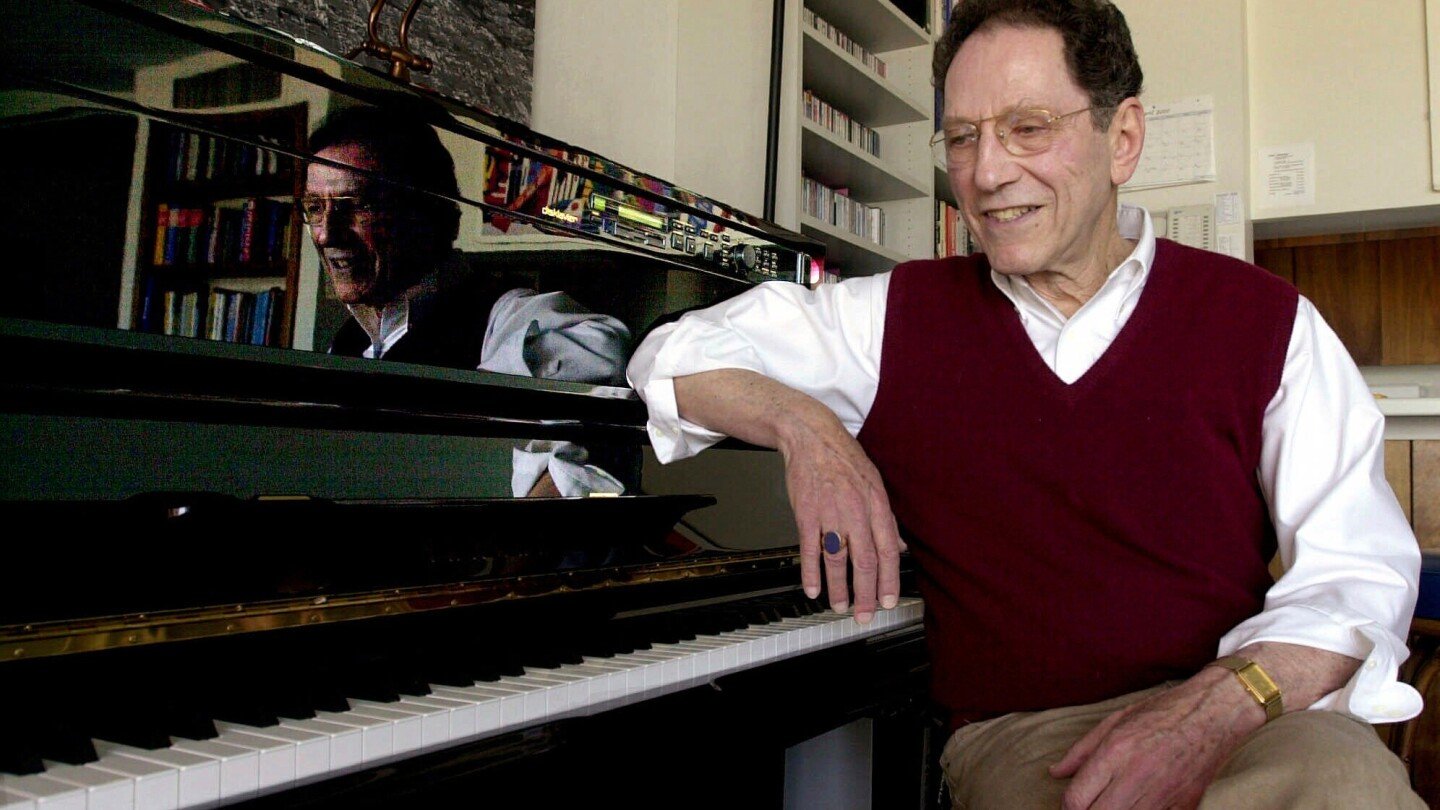Top Stories
Tom Lehrer, song satirist, dies at 97

LOS ANGELES (AP) — Tom Lehrer, the popular song satirist who lampooned marriage, politics, racism and the Cold War, then largely abandoned his music career to return to teaching math at Harvard and other universities, has died. He was 97.
Longtime friend David Herder said Lehrer died Saturday at his home in Cambridge, Massachusetts. He did not specify a cause of death.
Lehrer had remained on the math faculty of the University of California at Santa Cruz well into his late 70s. In 2020, he even turned away from his own copyright, granting the public permission to use his lyrics in any format without any fee in return.
A Harvard prodigy (he had earned a math degree from the institution at age 18), Lehrer soon turned his very sharp mind to old traditions and current events. His songs included “Poisoning Pigeons in the Park,” “The Old Dope Peddler” (set to a tune reminiscent of “The Old Lamplighter”), “Be Prepared” (in which he mocked the Boy Scouts) and “The Vatican Rag,” in which Lehrer, an atheist, poked at the rites and ceremonies of the Roman Catholic Church. (Sample lyrics: “Get down on your knees, fiddle with your rosaries. Bow your head with great respect, and genuflect, genuflect, genuflect.”)
Accompanying himself on piano, he performed the songs in a colorful style reminiscent of such musical heroes as Gilbert and Sullivan and Stephen Sondheim, the latter a lifelong friend. Lehrer was often likened to such contemporaries as Allen Sherman and Stan Freberg for his comic riffs on culture and politics and he was cited by Randy Newman and “Weird Al” Yankovic among others as an influence.
He mocked the forms of music he didn’t like (modern folk songs, rock ‘n’ roll and modern jazz), laughed at the threat of nuclear annihilation and denounced discrimination.
But he attacked in such an erudite, even polite, manner that almost no one objected.
“Tom Lehrer is the most brilliant song satirist ever recorded,” musicologist Barry Hansen once said. Hansen co-produced the 2000 boxed set of Lehrer’s songs, “The Remains of Tom Lehrer,” and had featured Lehrer’s music for decades on his syndicated “Dr. Demento” radio show.
Lehrer’s body of work was actually quite small, amounting to about three dozen songs.
“When I got a funny idea for a song, I wrote it. And if I didn’t, I didn’t,” Lehrer told The Associated Press in 2000 during a rare interview. “I wasn’t like a real writer who would sit down and put a piece of paper in the typewriter. And when I quit writing, I just quit. … It wasn’t like I had writer’s block.”
He’d gotten into performing accidentally when he began to compose songs in the early 1950s to amuse his friends. Soon he was performing them at coffeehouses around Cambridge, while he remained at Harvard to teach and obtain a master’s degree in math.
He cut his first record in 1953, “Songs by Tom Lehrer,” which included “I Wanna Go Back to Dixie,” lampooning the attitudes of the Old South, and the “Fight Fiercely, Harvard,” suggesting how a prissy Harvard blueblood might sing a football fight song.
After a two-year stint in the Army, Lehrer began to perform concerts of his material in venues around the world. In 1959, he released another LP called “More of Tom Lehrer” and a live recording called “An Evening Wasted with Tom Lehrer,” nominated for a Grammy for best comedy performance (musical) in 1960.
But around the same time, he largely quit touring and returned to teaching math, though he did some writing and performing on the side.
Lehrer said he was never comfortable appearing in public.
“I enjoyed it up to a point,” he told The AP in 2000. “But to me, going out and performing the concert every night when it was all available on record would be like a novelist going out and reading his novel every night.”
He did produce a political satire song each week for the 1964 television show “That Was the Week That Was,” a groundbreaking topical comedy show that anticipated “Saturday Night Live” a decade later.
He released the songs the following year in an album titled “That Was the Year That Was.” The material included “Who’s Next?” that ponders which government will be the next to get the nuclear bomb … perhaps Alabama? (He didn’t need to tell his listeners that it was a bastion of segregation at the time.) “Pollution” takes a look at the then-new concept that perhaps rivers and lakes should be cleaned up.
He also wrote songs for the 1970s educational children’s show “The Electric Company.” He told AP in 2000 that hearing from people who had benefited from them gave him far more satisfaction than praise for any of his satirical works.
His songs were revived in the 1980 musical revue “Tomfoolery” and he made a rare public appearance in London in 1998 at a celebration honoring that musical’s producer, Cameron Mackintosh.
Lehrer was born in 1928, in New York City, the son of a successful necktie designer. He recalled an idyllic childhood on Manhattan’s Upper West Side that included attending Broadway shows with his family and walking through Central Park day or night.
After skipping two grades in school, he entered Harvard at 15 and, after receiving his master’s degree, he spent several years unsuccessfully pursuing a doctorate.
“I spent many, many years satisfying all the requirements, as many years as possible, and I started on the thesis,” he once said. “But I just wanted to be a grad student, it’s a wonderful life. That’s what I wanted to be, and unfortunately, you can’t be a Ph.D. and a grad student at the same time.”
He began to teach part-time at Santa Cruz in the 1970s, mainly to escape the harsh New England winters.
From time to time, he acknowledged, a student would enroll in one of his classes based on knowledge of his songs.
“But it’s a real math class,” he said at the time. “I don’t do any funny theorems. So those people go away pretty quickly.”
___
Corrects spelling to ‘Yankovic,’ not ‘Jankovic’ in the fifth paragraph.
___
Former Associated Press writer John Rogers contributed to this story. Rogers retired from The AP in 2021.
Top Stories
Aid flotilla with Greta Thunberg set to sail for Gaza to ‘break illegal siege’ | Greta Thunberg

A flotilla carrying humanitarian aid and activists, including Swedish climate campaigner Greta Thunberg, is due to leave from Barcelona on Sunday to try to “break the illegal siege of Gaza”, organisers said.
The vessels will set off from the Spanish port city to “open a humanitarian corridor and end the ongoing genocide of the Palestinian people”, said the Global Sumud Flotilla.
They did not say how many ships would set sail or the exact time of departure.
The flotilla is expected to arrive at the war-ravaged coastal enclave in mid-September.
“This will be the largest solidarity mission in history, with more people and more boats than all previous attempts combined,” Brazilian activist Thiago Ávila told journalists in Barcelona last week.
Organisers say that dozens of other vessels are expected to leave Tunisian and other Mediterranean ports on 4 September.
Activists will also stage simultaneous demonstrations and other protests in 44 countries “in solidarity with the Palestinian people”, Thunberg, who is part of the flotilla’s steering committee, wrote on Instagram.
As well as Thunberg, the flotilla will include activists from several countries, European lawmakers and public figures such as former Barcelona mayor Ada Colau.
“We understand that this is a legal mission under international law,” leftwing Portuguese lawmaker Mariana Mortágua, who will join the mission, told journalists in Lisbon last week.
Israel has already blocked two attempts by activists to deliver aid by ship to Gaza, in June and July.
In June, 12 activists on board the sailboat Madleen were intercepted by Israeli forces 185km west of Gaza. Its passengers, who included Thunberg, were detained and eventually expelled.
In July, 21 activists from 10 countries were intercepted as they tried to approach Gaza in another vessel, the Handala.
Top Stories
No. 9 LSU outlasts No. 4 Clemson as Garrett Nussmeier outduels Cade Klubnik in top-10 showdown

No. 9 LSU went on the road and shocked No. 4 Clemson 17-10 to pick up a crucial road victory and firmly cement its place in the national championship picture. The battle went down to the final minutes, but LSU coach Brian Kelly finally picked up his first season-opening victory as Tigers coach.
Tied 10-10 at the start of the fourth quarter, LSU quarterback Garrett Nussmeier put together a legacy drive. After he was roughed on a completion to Aaron Anderson, Nussmeier ran for a third-down conversion and then found tight end Trey’Dez Green for an 8-yard touchdown to give LSU a lead it would never surrender.
Clemson had three more chances to get back into the end zone, turning it over on downs once and going three-and-out to set up a pivotal final drive. Clemson quarterback Cade Klubnik completed a big-time pass to T.J. Moore while taking a shot to lead a drive into the red zone. Facing fourth-and-4, LSU defender Harold Perkins brought pressure and forced an incompletion to end the game.
Playing against a phenomenal Clemson defense, Nussmeier stepped up big, completing 28 of 38 passes for 230 yards and a touchdown in the win. Anderson was his top target, catching six passes for 99 yards, including a 39-yarder. Running back Caden Durham went for 74 yards and a touchdown. Klubnik was strong, throwing for 230 yards, with four receivers hitting four catches. However, the lack of running game (20 carries for 31 yards) stood tall in the biggest moments.
Read on below for takeaways from LSU’s season-opening win over Clemson on Saturday.
Top Stories
Powerball jackpot jumps to an estimated $1.1 billion after no winning tickets in Saturday’s drawing

The Powerball jackpot has risen to an estimated $1.1 billion, the fifth-largest ever in the game’s history, after there were no winning tickets for Saturday night’s $1 billion grand prize.
Saturday’s winning numbers were 3, 18, 22, 27 and 33, with a Powerball of 17. There were nine tickets that matched all five white balls to win $1 million, but no ticket matched all six.
The $1.1 billion jackpot for Monday night’s drawing has an estimated cash value of $498.4 million.
Based on the jackpot estimate, a single jackpot winner Monday would have the choice of taking a lump sum payment of $498.4 million before taxes, or going with the annuity option, which would consist of one immediate payment followed by 29 annual payments that increase by 5% each year, each payment also before taxes.
Saturday’s drawing marked the sixth time in the game’s 33-year history that the top prize has climbed to the billion-dollar mark.
No one has won Powerball’s jackpot since May 31, when a single ticket in California won a $204.5 million jackpot with a cash value of $91.6 million.
Four of the five previous billion-plus-jackpot-winning tickets were sold in California, including a single ticket sold in Altadena in 2022 that claimed a $2.04 billion jackpot, the largest in both Powerball and lottery history.
The next drawing, which takes place from the Florida Lottery live draw studio in Tallahassee, is on Monday at 11 p.m. ET. Tickets are $2 and are sold in 45 states, the District of Columbia, Puerto Rico and the U.S. Virgin Islands.
contributed to this report.
-
Tools & Platforms3 weeks ago
Building Trust in Military AI Starts with Opening the Black Box – War on the Rocks
-

 Ethics & Policy1 month ago
Ethics & Policy1 month agoSDAIA Supports Saudi Arabia’s Leadership in Shaping Global AI Ethics, Policy, and Research – وكالة الأنباء السعودية
-

 Events & Conferences3 months ago
Events & Conferences3 months agoJourney to 1000 models: Scaling Instagram’s recommendation system
-

 Business2 days ago
Business2 days agoThe Guardian view on Trump and the Fed: independence is no substitute for accountability | Editorial
-

 Jobs & Careers2 months ago
Jobs & Careers2 months agoMumbai-based Perplexity Alternative Has 60k+ Users Without Funding
-

 Funding & Business2 months ago
Funding & Business2 months agoKayak and Expedia race to build AI travel agents that turn social posts into itineraries
-

 Education2 months ago
Education2 months agoVEX Robotics launches AI-powered classroom robotics system
-

 Podcasts & Talks2 months ago
Podcasts & Talks2 months agoHappy 4th of July! 🎆 Made with Veo 3 in Gemini
-

 Podcasts & Talks2 months ago
Podcasts & Talks2 months agoOpenAI 🤝 @teamganassi
-

 Jobs & Careers2 months ago
Jobs & Careers2 months agoAstrophel Aerospace Raises ₹6.84 Crore to Build Reusable Launch Vehicle





















